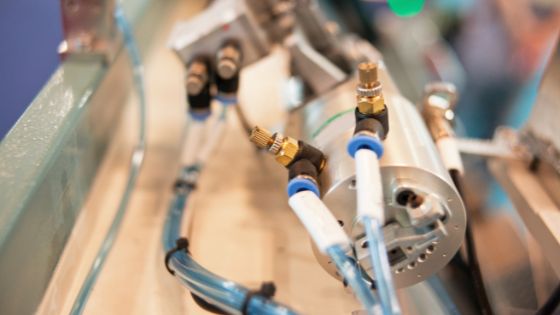An electronic proportional valve is a combination of hydraulic valve actuation with electronic control. A proportional valve is a hydraulic valve that can be electrically operated using proportional solenoids. Although proportional valves can be used for controlling the flow and pressure, it is important to ensure that the electronics are properly connected to this valve. A proportional valve can be used in places where pressure or flow must change continuously. A proportional valve can be used to replace multiple pressure and fixed flow valves. It also allows for acceleration and deceleration control. This valve can be used in a hydraulic system to reduce hydraulic circuitry components and increase efficiency and accuracy. An electronically controlled proportional flow valve can control flow based on the input current it receives.


What Are The Components of a Proportional Valve?
- Proportional solenoid.
- An area where the valve spool is located.
- The electronic position feedback device.
In applications that require precise speed control, such as acceleration or deceleration, the electronic proportional valve can be used to control hydraulic motors and cylinders. Proportional flow control valves can be pressure compensated to reduce flow variations caused by inlet or outlet pressure changes. Solenoids drive the valve’s spool in proportional valves.
Because proportional valve controller can control the fluid flow, speed, and direction with one valve, they are equipped with V notches. The same valve can also control the flow direction and actuator speed. Because the spool doesn’t move all at once, an electric proportional control valve can be used to control acceleration and deceleration.
The proportional valve’s electronic component will regulate the solenoids in accordance with the nominal value. The controlled buildup and decrease of the pressure are guaranteed. All analog values (nominal and measured) will be digitalized and used to calculate set values.
Use:
Modified versions of four-way solenoid vales, many proportional valves can be used to replace conventional pinch valve pneumatic solenoids. The solenoid force is counterbalanced by spring force to position the spool according to the input signal. The positioning accuracy can be improved by replacing the central springs with a sensor at the end. The sensor signal cancels the solenoid signal when the spool has reached the desired position. The spool of low-performing valves has a lot of overlap at the null position. This can lead to flow dead bands that can cause instability and errors in positioning systems.
The Pneumatic, electronic proportional valve design has one advantage: it eliminates friction, which is common with spool valves. The resultant flow is created by mechanical control of the position of the spool within the valve sleeve in standard spool valve designs. A spool can cause friction between the valve seat and the spool, which can reduce the valve’s life. The spool must be dithered when it is in motion to avoid friction. Stable flow control can be affected by dithering.
Proportional Valve vs. Servos:
A distinct trend in the industry of electronic proportional valve is formed: an increase in difficulty in distinguishing from proportional valves to servos. In the past, proportional valves were unable to compare to the performance of servo valves and were mainly utilized in open-loop systems. They were mass-produced, and servos required careful and precise production and were about ten times more costly. The proportional valves also had greater clearance, which meant they could withstand less contamination than valves for servos. Nowadays, proportional valve solenoid have begun to replace servos.
What are the Features of a Proportional Solenoid Valve:
The electronic proportional valve has a closed loop controlling system, which is why the valves are controlled by the electrical inputs from the sensor. Due to this feature, the proportional valve controller are used in various applications. These values have some safety features such as power failure and interruption of the electrical input and this is why the valve gets closed immediately. The best part is that these proportional valves have a long lifespan and it requires less maintenance.
How Proportional Valves are Constructed:
In the electronic proportional valve, the spools are made up of the hardened steel and its body is made of high grade hydraulic casting. The solenoids of the proportional control valve are coated with zinc color, while the housing is made of aluminum. In the casting body, the proportional spool slides in the casting body of the pressure controlling valve. Similar to the direction of the control valves, the construction is robust. The best part of the proportional regulator is that it has high capacity for the flow and they’re economical too. Its throttle section is formed by the notches cut into the spool. The geometry and notch size calculates the liquid and gas flow capacity of a given housing.
How to Select a Proportional Control Valve:
- You can choose the proportional control valve depending on the process that is used for the flow or pressure control
- Check whether the operating temperature of the system is appropriate or not for the proportional valve
- Check the repeatability and the repeatability is the flow rate of the valve
- Reverse sensitivity is the said to be the change in the electrical input, which is required to change the flow rate
- Threshold, it is the electrical input, which is necessary for the flow when at zero position.
What is a Hydraulic Proportional Valve:
The electronic proportional valve is most commonly used in hydraulic systems. The reason for it is that these valves are capable of changing the position of the spool many times depending on the received input. These proportional valves are utilized in the circuits, which requires more than one speed of actuators. These proportional valves can be used in the hydraulic system to control the pressure, flow, and direction of the fluids. You can increase the efficiency of the system by using the valve. So, you can say that you can control the flow, direction, and pressure by using the single valve and it will also simplify the circuit also.
Final Words:
In this post, we discussed what exactly the electronic proportional valve is and why it is used for. We also mention its working principles along with the selection criteria that can help you in deciding which one pressure controlling valve is best for your kind of application.


























